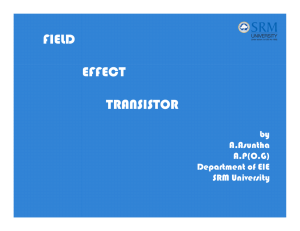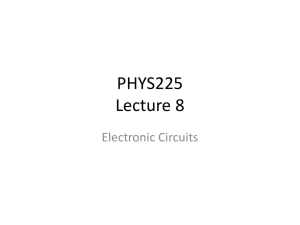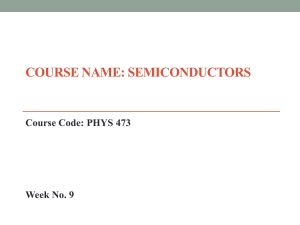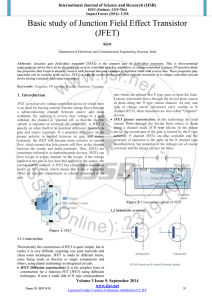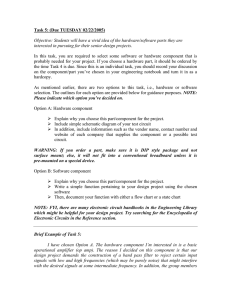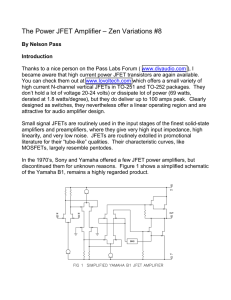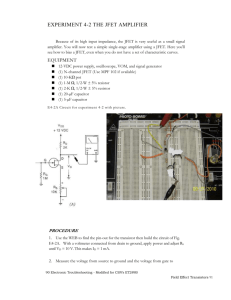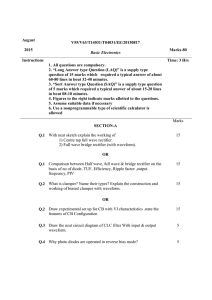Lecture (Week 10)
advertisement
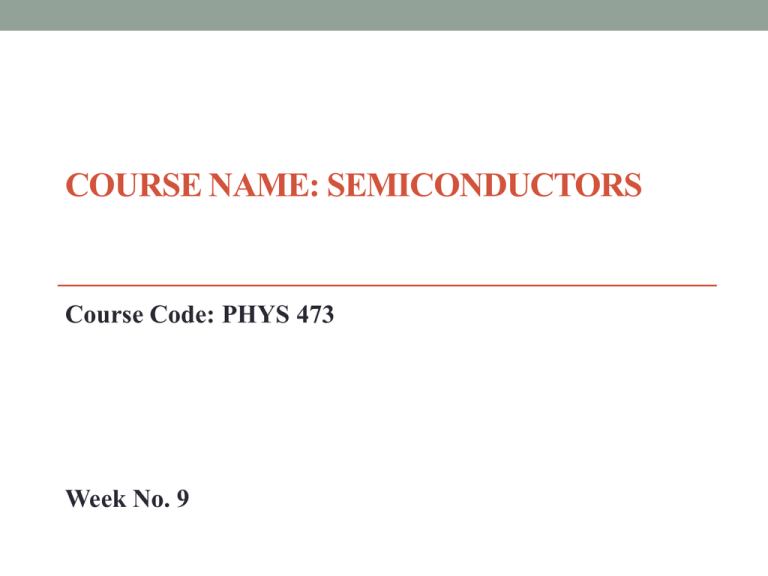
COURSE NAME: SEMICONDUCTORS Course Code: PHYS 473 Week No. 9 2 Field Effect Transistors (FET) Definition: In FET, output characteristics are controlled by input voltage (i.e., electric field) and not by input current. 3 Field Effect Transistors (FET) • Types of FET It has TWO types. •JFET: Junction FET •MOSFET: Metal–Oxide–Semiconductor FET D-MOSFET: Depletion MOSFET E-MOSFET: Enhancement MOSFET 4 Types of FET 5 Junction Field Effect Transistor (JFET) Definition: A JFET is a three terminal semiconductor device in which current conduction is by one type of carrier i.e., electrons or holes. The n-channel is more widely used. There are three terminals: • Drain (D) and Source (S) are connected to the n-channel • Gate (G) is connected to the ptype material 6 JFET operation The source of water pressure is the accumulation of electrons at the negative pole of the drain-source voltage. The drain of water is the electron deficiency (or holes) at the positive pole of the applied voltage. The control of flow of water is the gate voltage that controls the width of the nchannel and, therefore, the flow of charges from source to drain. 7 Junction Field Effect Transistor (JFET) Constructional details. A JFET consists of a p-type or n-type silicon bar containing two pn junctions at the sides as shown in Fig. The bar forms the conducting channel for the charge carriers. If the bar is of n-type, it is called nchannel JFET as shown in Fig. 8 Junction Field Effect Transistor (JFET) Constructional details. If the bar is of p-type, it is called a pchannel JFET as shown in Fig. The two pn junctions forming diodes are connected internally and a common terminal called gate is taken out. Other terminals are source and drain taken out from the bar as shown. Thus a JFET has essentially three terminals viz., gate (G), source (S) and drain (D). 9 JFET polarities Fig. (i) & (ii) shows n-channel and p-channel JFET polarities Note that in each case, the voltage between the gate and source is such that the gate is reverse biased. The drain and source terminals are interchangeable i.e., either end can be used as source and the other end as drain. (i) (ii) 10 Principle of JFET JFET operates on the principle that width and hence resistance of the conducting channel can be varied by changing the reverse voltage VGS. Schematic Symbol of JFET N-channel JFET P-channel JFET 11 Difference Between JFET and Bipolar Transistor FET BJT 12 Difference Between JFET and Bipolar Transistor 13 Difference Between JFET and Bipolar Transistor 14 Output Characteristics of JFET Definition: The curve between drain current (ID) and drain-source voltage (VDS) of a JFET at constant gate- source voltage (VGS) is known as output characteristics of JFET. 15 Salient Features of JFET A JFET is a three-terminal voltage-controlled semiconductor device i.e. input voltage controls the output characteristics of JFET. 2. The JFET is always operated with gate-source pn junction reverse biased. 3. In a JFET, the gate current is zero i.e. IG = 0A. 4. Since there is no gate current, ID = IS. 1. 5. The JFET must be operated between VGS and VGS(off). For this range of gate-to-source voltages, ID will vary from a maximum of IDSS to a minimum of almost zero. 16 Salient Features of JFET 6. The drain current ID is controlled by changing the channel width. 7. Since JFET has no gate current, there is no b rating of the device. We can find drain current ID by using the eq. ID I VGS DSS 1 V GS(o ff) 2 17 Important Terms Shorted-gate drain current (IDSS): It is the drain current with source short-circuited to gate (i.e. VGS = 0) and drain voltage (VDS) equal to pinch off voltage. It is sometimes called zero-bias current. Pinch off Voltage (VP). It is the minimum drain-source voltage at which the drain current essentially becomes constant. Gate-source cut off voltage VGS(off). It is the gate-source voltage where the channel is completely cut off and the drain current becomes zero. 18 Graph between ID and VDS for the shorted gate condition 19 Drain curves of a JFET 20 Transfer characteristic of a JFET 21 Q 1. 22 Q 2. 23 Q 3. 24 Q 4. 25 Q 5. 26 Advantages of JFET • High input impedance (M) • Temperature stable than BJT • Smaller than BJT • Can be fabricated with fewer processing • BJT is bipolar – conduction both hole and electron • FET is unipolar – uses only one type of current carrier • Less noise compare to BJT • Usually use as logic switch
